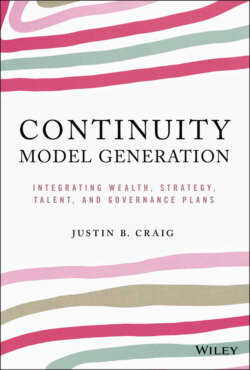Читать книгу Continuity Model Generation - Justin B. Craig - Страница 17
Two Complementary Logics
ОглавлениеOne simple way to understand what's different about family enterprises is to consider that they are driven by two complementary logics. Specifically, they pursue economic and social agendas concurrently. They balance doing well and doing good. They are committed to a healthy business with a long-term perspective characterized by patient capital and at the same time dedicated to contributing to the social wellbeing of their family, employees, and the communities in which they operate. Understanding this keystone characteristic is important for the development of a continuity model mindset.
Again, this is not hard to understand, and for some it may even sound overly simplistic. But in order to set a solid foundation and to educate now- and next-generation members, simple messages are the best. By framing the distinction as two complementary logics—those associated with economic and social agendas—you can share a simple, easily understood “story.” Simple stories are best. It is also possible to draw this distinction to explain something vital. The way I like to do this is by drawing two connected circles, one with a heart and the other with a dollar sign. That picture paints more than a thousand words, leaving nothing more to be said. I encourage you to test this approach. Actually, throughout the book you'll find simple-to-replicate images that bring the ideas here to life effectively and efficiently. None are simpler than this one (Illustration 6).
But to understand the logics concepts even further, consider two exemplars of them: S.C. Johnson and Corning.
Samuel C. Johnson, then-fourth-generation leader of S.C. Johnson, captures his firm's economic and social motivations in his collection of essays to celebrate the company's one-hundred-year anniversary in 1986. He writes, “when family ownership places a family member in control of a company, and everyone in the firm knows clearly who the boss is, and who will still be the boss in five or ten years hence, then there's a palpable air of stability” (Johnson 1988, p. 7). The Johnsons expect brave decision-making by their generational leaders and have a proud history of each generation bringing something new to the enterprise: “that is, something that hadn't been thought of by—and beyond the visions of—the previous generations” (Johnson 1988, p. 8). At the same time, S.C. Johnson's leaders are acutely aware that they serve under the watchful eye of the founders. As Sam Johnson pointed out, family companies have the capacity to “do things of social or cultural value that a public company might be reluctant even to entertain,” as they have the discretion to “do those things to contribute to enhance the communities in which we live and work without having to explain it to thousands and thousands of people over and over” (Johnson 1988, p. 13).
The social and economic interplay manifests in the US city of Racine, Wisconsin, home of the S.C. Johnson organization. A recent visit confirmed the prominence of the Johnson family in the town; beyond core business activities, other commercial operations include the Johnson Financial Group, the Johnson Bank, and Johnson Outdoors. There is also Sam Johnson Parkway, which leads to a Johnson-funded public square. The Johnson family has also endowed the Racine Museum of Art.
Another example is in the city of Corning, New York, home of the fifth-generation Houghton family's Corning Glass Works, where family connections and values account for much of the business's character and culture, with a focus on the social and economic wellbeing of the firm and its environment. When floodwaters destroyed the glassworks in 1972 and threatened the continuity of the business, then-Chairman Amory Houghton went on local radio to rally the company and community, “We are not only going to rebuild what we have lost, but we are going to add significantly to our manufacturing facilities in one of our plants…I want those of you who are employees of our company to know that as long as we respond well to our customer's needs your jobs are secure. Not a flood, nor a hurricane, not any other act of nature is going to jeopardize this. You are the Corning Glass Works, particularly in this city which is our home and our headquarters” (Dyer and Gross, 2001, p. 313).
Most notable is the positioning of continuity as the family's metric of success. By positioning this as their desired outcome and highlighting the economic and social aspects of achieving this, they acknowledge the role that their business families play in commerce and society.
Illustration 6 TWO COMPLEMENTARY LOGICS
